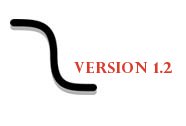Introduction
First step: Data Entry
Enter the concentration values in ascending order (X-axis) in nM or in ng/mL. The raw effect values (Y-axis) can be entered in any unit (cpm, mOD, fluorescence unit…), previously specified in the Analysis Information part. You can copy-paste the data from any spreadsheet (ex: Excel).
Beware: if the entered values are too erroneous, it may provide calculation error in the R code and the website will display a “Page cannot be displayed” error page. You may then use the Previous button on your internet navigator to return to your entered data and check them. Same can happen if data are too different from a decreasing sigmoid shape.
First step: Check
Null concentration (C0): no drug is used so the level of parasitemia is the highest.
Maximum concentration (Cmax): highest concentration of drug which gives the lowest level of parasitemia
ICEstimator will convert the effect into relative effects in % before running the regression. The raw effect(s) for C0 are used to derive the 100% relative effect. The raw effect(s) for the Cmax are used to derive the 0% relative effect.
This step is to check the graphs obtained before the estimation is performed.
When you reach the Check Step a window with the graph representing your data and a table with the growth ratio opens.
Choose:
- Click on Proceed with the next stage, if you think that your data file does not contain erroneous values.
- Go back to previous page, if you think your entered data file cannot be validated because of erroneous values and change them.
Second step: Run Regression
A first run is performed where γ is estimated. If the run does not converge then a second estimation is performed with γ fixed to 10 and the results from this last run are reported. If this second estimation does not converge a message is indicated.
An in vitro test shows good results when the Effect-Concentration response depicts a sigmoid curve with a low dispersion of points (the 95% Confidence Interval must be tight).
The results are presented by a table and two graphs. The table contains the IC50 (50% Inhibitory Concentration), IC90 (90% Inhibitory Concentration), IC99 (99% Inhibitory Concentration), their 95% Confidence Intervals and the Confidence Interval ratio. The table also contains γ with its 95% Confidence Intervals. In addition to the table, two graphs representing the data and the fitting curve are displayed: the first one uses a normal scale and the second one uses a log normal scale in which the null concentration had been replaced by the second concentration divided by 100.
Click on “Download the table” to get a csv file with all entered description, the estimated parameters, their confidence intervals and the confidence interval ratios.
Click on “Download the results in pdf format” to get a pdf file with the graphs, the estimated parameters, their confidence intervals and the confidence interval ratios.
Click on “Download observed and predicted data” to get a csv file with the concentrations, the raw effects, the relative effects and the predicted relative effects.

Version 1.2 new features
What is new?
- A table with the mean effect at null concentration, the mean effect at maximal concentration and the ratio of the first over the second was added (at the check step)
- IC90 and its confidence interval
- IC99 and its confidence interval
- Ratio of upper/lower bounds of CI95% for IC50, IC90 and IC99
- PDF output with the table and graphs
- The warning messages are written in red
Bugs fixed
- In « download the results », the information on the top has been well aligned
- In « download and observed predicted data », the number of decimal for relative effect and prediction have been reduced to 2
- The drawing of the curve in the graph using the log scale has been corrected, the red line is drawn from the Y-axis
- Previously when the ratio upper/lower bounds of CI95% for IC50 was greater to 3, the gamma value was fixed to 10. Now when the Ratio of upper/lower bounds of CI95% for IC50 is greater then 2, a message warns the user
- Previously the graph using the log scale did not display data for null concentration. It now displays a modified value for the null concentration which is the 2nd concentration divided by 100

|






